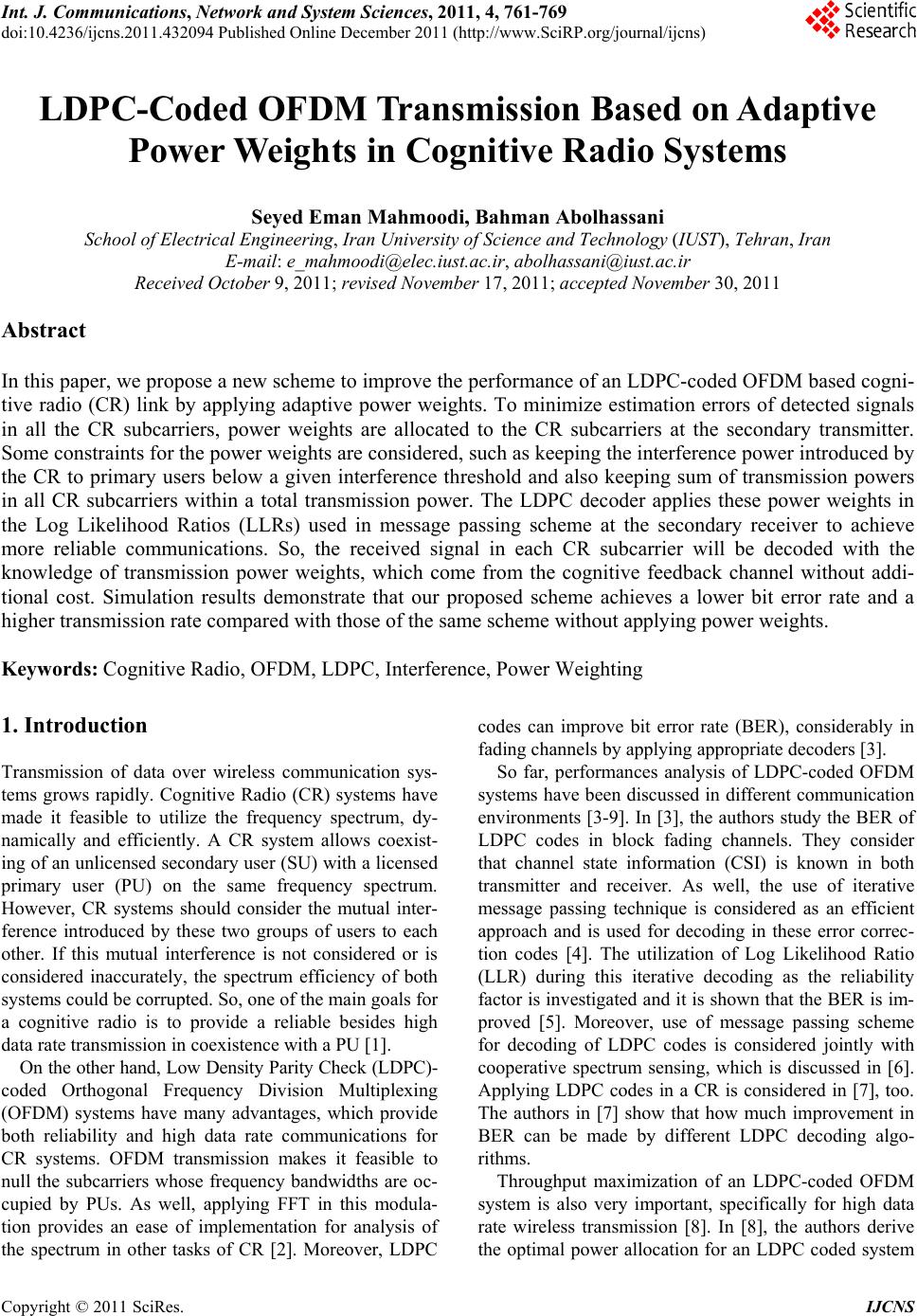 Int. J. Communications, Network and System Sciences, 2011, 4, 761-769 doi:10.4236/ijcns.2011.432094 Published Online December 2011 (http://www.SciRP.org/journal/ijcns) Copyright © 2011 SciRes. IJCNS LDPC-Coded OFDM Transmission Based on Adaptive Power Weights in Cognitive Radio Systems Seyed Eman Mahmoodi, Bahman Abolhassani School of Electrical Engineering, Iran University of Science and Technology (IUST), Tehran, Iran E-mail: e_mahmoodi@elec.iust.ac.ir, abolhassani@iust.ac.ir Received October 9, 2011; revised November 17, 2011; accepted November 30, 2011 Abstract In this paper, we propose a new scheme to improve the performance of an LDPC-coded OFDM based cogni- tive radio (CR) link by applying adaptive power weights. To minimize estimation errors of detected signals in all the CR subcarriers, power weights are allocated to the CR subcarriers at the secondary transmitter. Some constraints for the power weights are considered, such as keeping the interference power introduced by the CR to primary users below a given interference threshold and also keeping sum of transmission powers in all CR subcarriers within a total transmission power. The LDPC decoder applies these power weights in the Log Likelihood Ratios (LLRs) used in message passing scheme at the secondary receiver to achieve more reliable communications. So, the received signal in each CR subcarrier will be decoded with the knowledge of transmission power weights, which come from the cognitive feedback channel without addi- tional cost. Simulation results demonstrate that our proposed scheme achieves a lower bit error rate and a higher transmission rate compared with those of the same scheme without applying power weights. Keywords: Cognitive Radio, OFDM, LDPC, Interference, Power Weighting 1. Introduction Transmission of data over wireless communication sys- tems grows rapidly. Cognitive Radio (CR) systems have made it feasible to utilize the frequency spectrum, dy- namically and efficiently. A CR system allows coexist- ing of an unlicensed secondary user (SU) with a licensed primary user (PU) on the same frequency spectrum. However, CR systems should consider the mutual inter- ference introduced by these two groups of users to each other. If this mutual interference is not considered or is considered inaccurately, the spectrum efficiency of both systems could be corrupted. So, one of the main goals for a cognitive radio is to provide a reliable besides high data rate transmission in coexistence with a PU [1]. On the other hand, Low Density Parity Check (LDPC)- coded Orthogonal Frequency Division Multiplexing (OFDM) systems have many advantages, which provide both reliability and high data rate communications for CR systems. OFDM transmission makes it feasible to null the subcarriers whose frequency bandwidths are oc- cupied by PUs. As well, applying FFT in this modula- tion provides an ease of implementation for analysis of the spectrum in other tasks of CR [2]. Moreover, LDPC codes can improve bit error rate (BER), considerably in fading channels by applying appropriate decoders [3]. So far, performances analysis of LDPC-coded OFDM systems have been discussed in different communication environments [3-9]. In [3], the authors study the BER of LDPC codes in block fading channels. They consider that channel state information (CSI) is known in both transmitter and receiver. As well, the use of iterative message passing technique is considered as an efficient approach and is used for decoding in these error correc- tion codes [4]. The utilization of Log Likelihood Ratio (LLR) during this iterative decoding as the reliability factor is investigated and it is shown that the BER is im- proved [5]. Moreover, use of message passing scheme for decoding of LDPC codes is considered jointly with cooperative spectrum sensing, which is discussed in [6]. Applying LDPC codes in a CR is considered in [7], too. The authors in [7] show that how much improvement in BER can be made by different LDPC decoding algo- rithms. Throughput maximization of an LDPC-coded OFDM system is also very important, specifically for high data rate wireless transmission [8]. In [8], the authors derive the optimal power allocation for an LDPC coded system 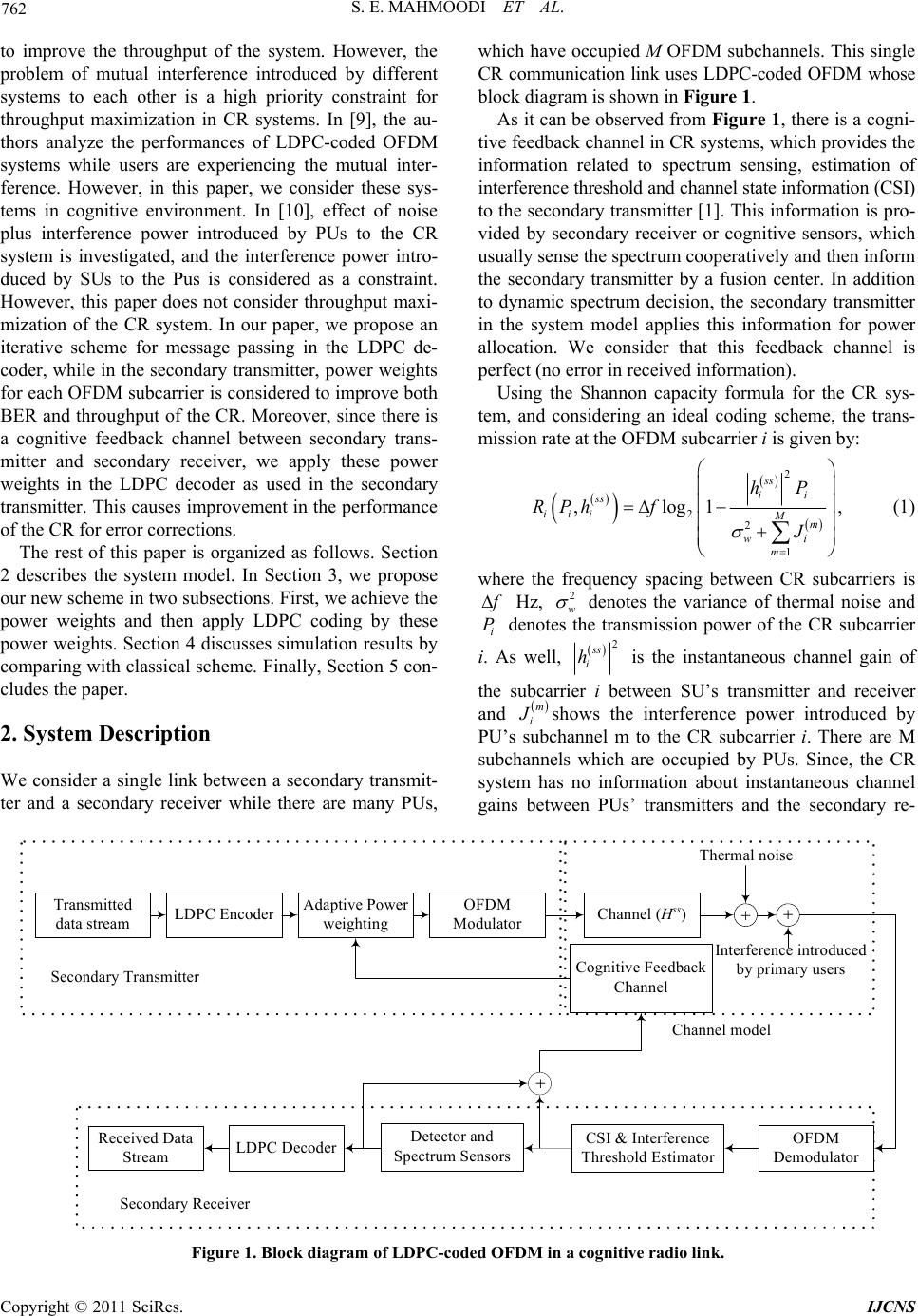 762 S. E. MAHMOODI ET AL. to improve the throughput of the system. However, the problem of mutual interference introduced by different systems to each other is a high priority constraint for throughput maximization in CR systems. In [9], the au- thors analyze the performances of LDPC-coded OFDM systems while users are experiencing the mutual inter- ference. However, in this paper, we consider these sys- tems in cognitive environment. In [10], effect of noise plus interference power introduced by PUs to the CR system is investigated, and the interference power intro- duced by SUs to the Pus is considered as a constraint. However, this paper does not consider throughput maxi- mization of the CR system. In our paper, we propose an iterative scheme for message passing in the LDPC de- coder, while in the secondary transmitter, power weights for each OFDM subcarrier is considered to improve both BER and throughput of the CR. Moreover, since there is a cognitive feedback channel between secondary trans- mitter and secondary receiver, we apply these power weights in the LDPC decoder as used in the secondary transmitter. This causes improvement in the performance of the CR for error corrections. The rest of this paper is organized as follows. Section 2 describes the system model. In Section 3, we propose our new scheme in two subsections. First, we achieve the power weights and then apply LDPC coding by these power weights. Section 4 discusses simulation results by comparing with classical scheme. Finally, Section 5 con- cludes the paper. 2. System Description We consider a single link between a secondary transmit- ter and a secondary receiver while there are many PUs, which have occupied M OFDM subchannels. This single CR communication link uses LDPC-coded OFDM whose block diagram is shown in Fi gu r e 1. As it can be observed from Figure 1, there is a cogni- tive feedback channel in CR systems, which provides the information related to spectrum sensing, estimation of interference threshold and channel state information (CSI) to the secondary transmitter [1]. This information is pro- vided by secondary receiver or cognitive sensors, which usually sense the spectrum cooperatively and then inform the secondary transmitter by a fusion center. In addition to dynamic spectrum decision, the secondary transmitter in the system model applies this information for power allocation. We consider that this feedback channel is perfect (no error in received information). Using the Shannon capacity formula for the CR sys- tem, and considering an ideal coding scheme, the trans- mission rate at the OFDM subcarrier i is given by: 2 2 2 1 ,log1 ss ii ss iii Mm wi m hP RPh f J , (1) where the frequency spacing between CR subcarriers is Hz, 2 w denotes the variance of thermal noise and i P denotes the transmission power of the CR subcarrier i. As well, 2 ss i h is the instantaneous channel gain of the subcarrier i between SU’s transmitter and receiver and m i shows the interference power introduced by PU’s subchannel m to the CR subcarrier i. There are M subchannels which are occupied by PUs. Since, the CR system has no information about instantaneous channel gains between PUs’ transmitters and the secondary re- Channel model Cognitive Feedback Channel Transmitted data streamLDPC EncoderOFDM Modulator Channel (Hss) Thermal noise Adaptive Power weighting Interference introduced by primary users OFDM Demodulator LDPC Decoder Received Data Stream Detector and Spectrum Sensors CSI & Interference Threshold Estimator Secondary Receiver Secondary Transmitter Figure 1. Block diagram of LDPC-coded OFDM in a cognitive radio link. Copyright © 2011 SciRes. IJCNS  S. E. MAHMOODI ET AL. Copyright © 2011 SciRes. IJCNS 763 ceiver and modulation strategy of PUs, precise calcula- tion of the interference power introduced by PUs is in- feasible for the CR. On the other hand, estimation of these interference powers, m i (for all ), is possible at the SU’s transmitter. However, for consid- ering PUs’ activities, the CR needs to update the estima- tion of the interference powers, periodically. This is im- practical for large number of OFDM subchannels, which consists of CR subcarriers and the subchannels occupied by PUs. This makes the CR very slow to perform estima- tion at the secondary receiver and then feedback to the SU’s transmitter for transmission power weighting. 1, 2,,mM Since, we consider an imperfect spectrum sensing and we cannot estimate noise variance plus the sum interfere- ence power introduced by PUs accurately, applying LDPC coding seems an efficient solution to have a CR system with an acceptable performance. To make this LDPC coding even more efficient, using message pas- sing scheme, power weights are passed to the LDPC de- coder to be used for a more efficient decoding. We assume a linear model for the received voltage signal, as , ss i yiwhixini=+ (2) where denotes the signal weight of CR subcarrier i. Also, i w i and i are the transmitted and received voltage signals in CR subcarrier i, respectively and ni denotes total power of interference generated by M sub- channels of PUs and received by the CR receiver in sub- carrier i and thermal noise, which is AWGN with zero mean and variance 2 w . The receiver should estimate ˆ i, the transmitted signal in each subcarrier. Using [11], the LS estimation of ˆ i is given by 0, 0, ˆ, ss ss ii ii yi ni xi xi wPhiwPhi (4) where 0,i denotes the initial power of CR subcarrier i, which has equal value for all N subcarriers, that is P 0, 1, 2,,. T i P Pi N N (5) In Equation (4), noise and the interference coming from PUs are included in wi. Also, from Equation (4), the variance of the LS estimation of ˆ i is given by 2 1 2 0, 1. Mm wi m iss ii J wP hi 2 (6) This equation shows that to minimize Δi, for small values of the ratio of the channel gain to noise plus in- terference, weight of transmission power should be increased. 2 i w 3. Proposed Scheme In this section, we propose our new scheme which con- sists of two important phases. In the first phase, we achieve transmission power weights in all CR subcarriers at the secondary transmitter. Then, using these power weights in the LDPC decoder of the CR receiver, we improve system performance of the CR in the second phase. In the following two subsections, we explain these two phases. 3.1. Phase I: Calculations of Power Weights Knowledge on the summation of interference powers introduced by PUs is infeasible in this system model, and applying Equation (1) for rate maximization in LDPC- coded system is inefficient. So, we consider the objective function proposed in [12], to achieve power weights. We write the summation of estimation errors of ˆ i, 1, 2,, iN , for all N subcarriers of the CR system as 2 11 1 12 2 2 00 0, ,,,. (7) Mm wi NN m Ni ss ii ii J ww w wP hi By considering Equation (7) normalized to the noise variance plus summation of interference powers intro- duced by PUs as the objective function, we solve opti- mization problem to allocate adaptive transmission po- wer weights for each secondary subcarrier. Then, we use these weights in the LDPC decoding. By minimizing Δ, signal estimation errors decrease. In other words, by maximizing inverse of Δ, actually, we consider the maximization of the total signal to interfere- ence plus noise (SINR) in all CR subcarriers. However, as was expressed in system description, the CR is un- aware of the transmission power levels of the PUs and their channel gains to the secondary receivers, so calcu- lation of the interference introduced by PUs is infeasible. So, we normalize the sum of estimation errors (Δ) to noise plus sum interference. This normalization results in calculation of suboptimum transmission power weights 2. i ws However, the optimization problem would be feasible without knowing the noise plus interference power. Also, the optimization problem has some con- straints, which should be noted for reliable communica- tions in the primary system and total transmission power of the SU. This optimization problem could be mathe- matically written as, 12 2 0, 0 max , i Nss ii wi wP hi (8) 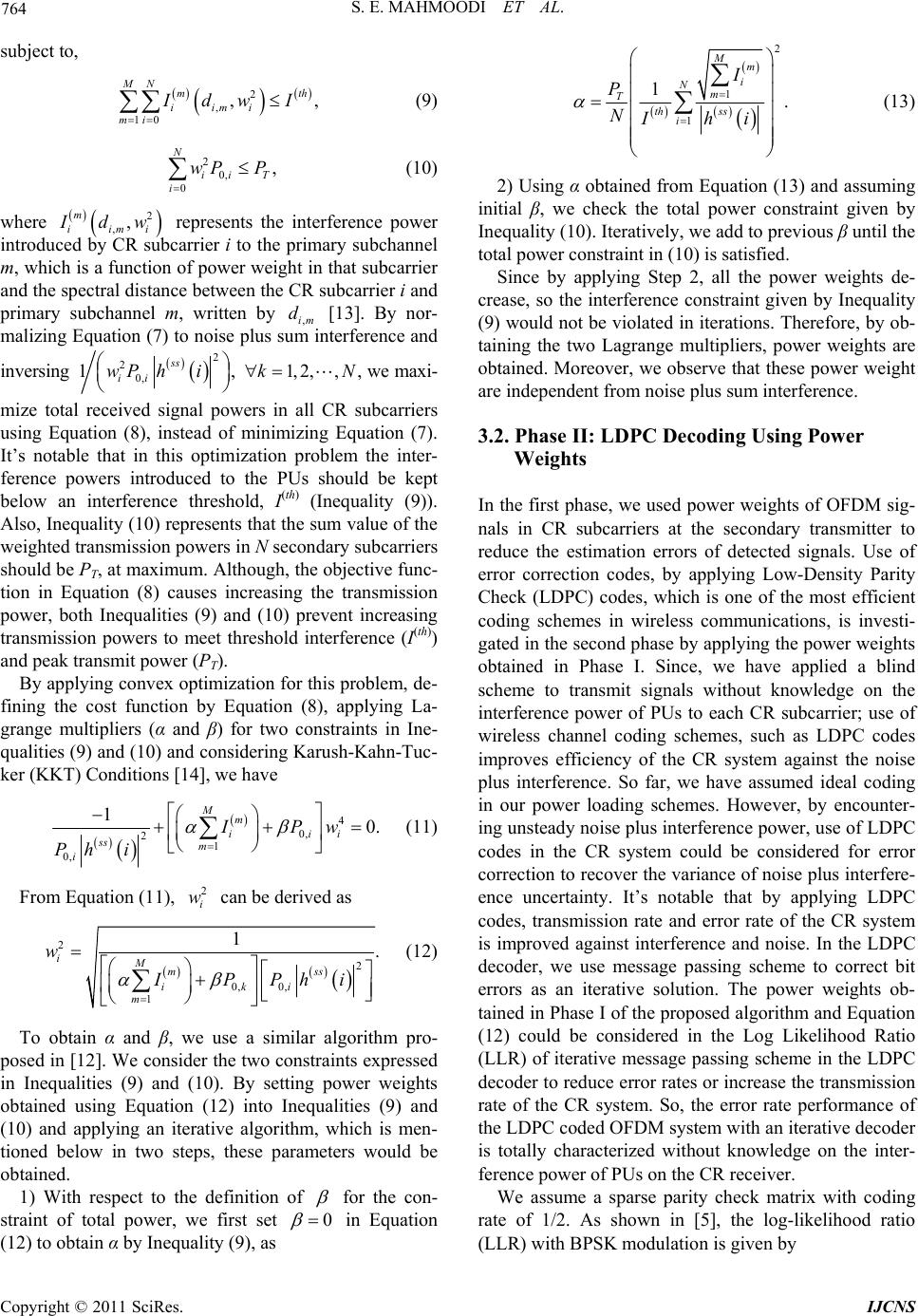 S. E. MAHMOODI ET AL. 764 , t h subject to, 2 , 10 , MN m iimi mi dw I (9) 2 0, 0 , N ii T i wP P (10) where 2 ,, m iimi dw represents the interference power introduced by CR subcarrier i to the primary subchannel m, which is a function of power weight in that subcarrier and the spectral distance between the CR subcarrier i and primary subchannel m, written by ,im [13]. By nor- malizing Equation (7) to noise plus sum interference and d inversing 2 2 0, 1ss ii wP hi , 1, 2,,kN , we maxi- mize total received signal powers in all CR subcarriers using Equation (8), instead of minimizing Equation (7). It’s notable that in this optimization problem the inter- ference powers introduced to the PUs should be kept below an interference threshold, I(th) (Inequality (9)). Also, Inequality (10) represents that the sum value of the weighted transmission powers in N secondary subcarriers should be PT, at maximum. Although, the objective func- tion in Equation (8) causes increasing the transmission power, both Inequalities (9) and (10) prevent increasing transmission powers to meet threshold interference (I(th)) and peak transmit power (PT). By applying convex optimization for this problem, de- fining the cost function by Equation (8), applying La- grange multipliers (α and β) for two constraints in Ine- qualities (9) and (10) and considering Karush-Kahn-Tuc- ker (KKT) Conditions [14], we have 4 0, 2 1 0, 10. Mm iii ss m i IPw Ph i (11) From Equation (11), can be derived as 2 i w 2 2 0, 0, 1 1. iMms iki m w IPPhi s (12) To obtain α and β, we use a similar algorithm pro- posed in [12]. We consider the two constraints expressed in Inequalities (9) and (10). By setting power weights obtained using Equation (12) into Inequalities (9) and (10) and applying an iterative algorithm, which is men- tioned below in two steps, these parameters would be obtained. 1) With respect to the definition of for the con- straint of total power, we first set 0 in Equation (12) to obtain α by Inequality (9), as 2 1 1 1. Mm i Nm T th ss i I P NIhi (13) 2) Using α obtained from Equation (13) and assuming initial β, we check the total power constraint given by Inequality (10). Iteratively, we add to previous β until the total power constraint in (10) is satisfied. Since by applying Step 2, all the power weights de- crease, so the interference constraint given by Inequality (9) would not be violated in iterations. Therefore, by ob- taining the two Lagrange multipliers, power weights are obtained. Moreover, we observe that these power weight are independent from noise plus sum interference. 3.2. Phase II: LDPC Decoding Using Power Weights In the first phase, we used power weights of OFDM sig- nals in CR subcarriers at the secondary transmitter to reduce the estimation errors of detected signals. Use of error correction codes, by applying Low-Density Parity Check (LDPC) codes, which is one of the most efficient coding schemes in wireless communications, is investi- gated in the second phase by applying the power weights obtained in Phase I. Since, we have applied a blind scheme to transmit signals without knowledge on the interference power of PUs to each CR subcarrier; use of wireless channel coding schemes, such as LDPC codes improves efficiency of the CR system against the noise plus interference. So far, we have assumed ideal coding in our power loading schemes. However, by encounter- ing unsteady noise plus interference power, use of LDPC codes in the CR system could be considered for error correction to recover the variance of noise plus interfere- ence uncertainty. It’s notable that by applying LDPC codes, transmission rate and error rate of the CR system is improved against interference and noise. In the LDPC decoder, we use message passing scheme to correct bit errors as an iterative solution. The power weights ob- tained in Phase I of the proposed algorithm and Equation (12) could be considered in the Log Likelihood Ratio (LLR) of iterative message passing scheme in the LDPC decoder to reduce error rates or increase the transmission rate of the CR system. So, the error rate performance of the LDPC coded OFDM system with an iterative decoder is totally characterized without knowledge on the inter- ference power of PUs on the CR receiver. We assume a sparse parity check matrix with coding rate of 1/2. As shown in [5], the log-likelihood ratio (LLR) with BPSK modulation is given by Copyright © 2011 SciRes. IJCNS 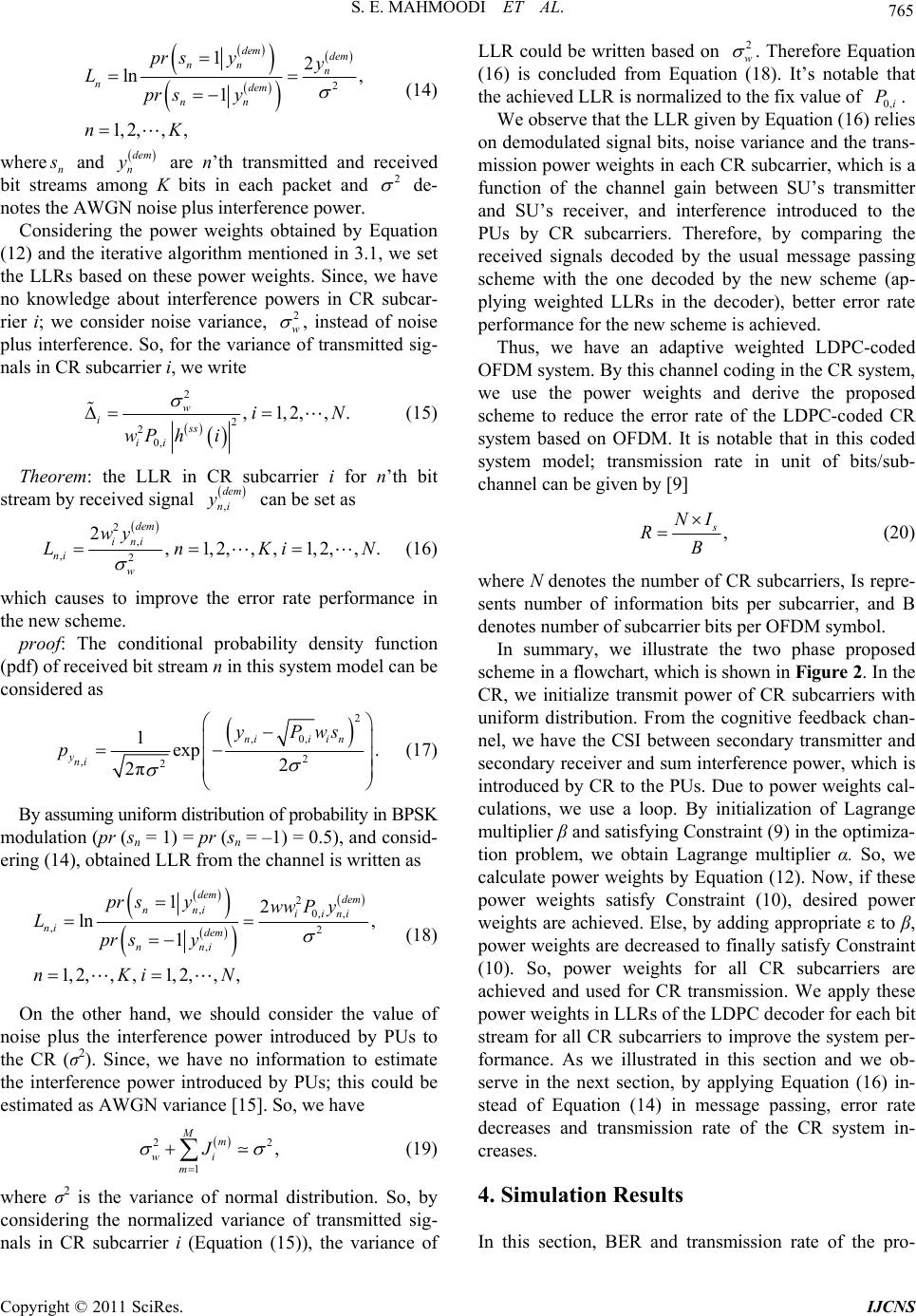 S. E. MAHMOODI ET AL. 765 2 12 ln , 1 1, 2,,, dem dem nn n ndem nn pr syy L pr sy nK (14) where n and are n’th transmitted and received bit streams among K bits in each packet and dem n y 2 de- notes the AWGN noise plus interference power. Considering the power weights obtained by Equation (12) and the iterative algorithm mentioned in 3.1, we set the LLRs based on these power weights. Since, we have no knowledge about interference powers in CR subcar- rier i; we consider noise variance, 2 w , instead of noise plus interference. So, for the variance of transmitted sig- nals in CR subcarrier i, we write 2 2 2 0, ,1,2,, w iss ii i wP hi .N (15) Theorem: the LLR in CR subcarrier i for n’th bit stream by received signal can be set as , dem ni y 2 , ,2 2,1,2, ,,1,2, ,. dem ini ni w wy LnKi N (16) which causes to improve the error rate performance in the new scheme. proof: The conditional probability density function (pdf) of received bit stream n in this system model can be considered as 2 ,0, 2 ,2 1exp . 2 2π niii n yni yPws p (17) By assuming uniform distribution of probability in BPSK modulation (pr (sn = 1) = pr (sn = –1) = 0.5), and consid- ering (14), obtained LLR from the channel is written as 2 ,0, , ,2 , 12 ln , 1 1, 2,,,1, 2,,, dem dem nni iini ni dem nni pr syww Py L pr sy nKiN (18) On the other hand, we should consider the value of noise plus the interference power introduced by PUs to the CR (σ2). Since, we have no information to estimate the interference power introduced by PUs; this could be estimated as AWGN variance [15]. So, we have 2 1 , Mm wi m J2 (19) where σ2 is the variance of normal distribution. So, by considering the normalized variance of transmitted sig- nals in CR subcarrier i (Equation (15)), the variance of LLR could be written based on 2 w . Therefore Equation (16) is concluded from Equation (18). It’s notable that the achieved LLR is normalized to the fix value of . 0,i We observe that the LLR given by Equation (16) relies on demodulated signal bits, noise variance and the trans- mission power weights in each CR subcarrier, which is a function of the channel gain between SU’s transmitter and SU’s receiver, and interference introduced to the PUs by CR subcarriers. Therefore, by comparing the received signals decoded by the usual message passing scheme with the one decoded by the new scheme (ap- plying weighted LLRs in the decoder), better error rate performance for the new scheme is achieved. P Thus, we have an adaptive weighted LDPC-coded OFDM system. By this channel coding in the CR system, we use the power weights and derive the proposed scheme to reduce the error rate of the LDPC-coded CR system based on OFDM. It is notable that in this coded system model; transmission rate in unit of bits/sub- channel can be given by [9] , NI RB (20) where N denotes the number of CR subcarriers, Is repre- sents number of information bits per subcarrier, and B denotes number of subcarrier bits per OFDM symbol. In summary, we illustrate the two phase proposed scheme in a flowchart, which is shown in Figure 2 . In the CR, we initialize transmit power of CR subcarriers with uniform distribution. From the cognitive feedback chan- nel, we have the CSI between secondary transmitter and secondary receiver and sum interference power, which is introduced by CR to the PUs. Due to power weights cal- culations, we use a loop. By initialization of Lagrange multiplier β and satisfying Constraint (9) in the optimiza- tion problem, we obtain Lagrange multiplier α. So, we calculate power weights by Equation (12). Now, if these power weights satisfy Constraint (10), desired power weights are achieved. Else, by adding appropriate ε to β, power weights are decreased to finally satisfy Constraint (10). So, power weights for all CR subcarriers are achieved and used for CR transmission. We apply these power weights in LLRs of the LDPC decoder for each bit stream for all CR subcarriers to improve the system per- formance. As we illustrated in this section and we ob- serve in the next section, by applying Equation (16) in- stead of Equation (14) in message passing, error rate decreases and transmission rate of the CR system in- creases. 4. Simulation Results In this section, BER and transmission rate of the pro- Copyright © 2011 SciRes. IJCNS 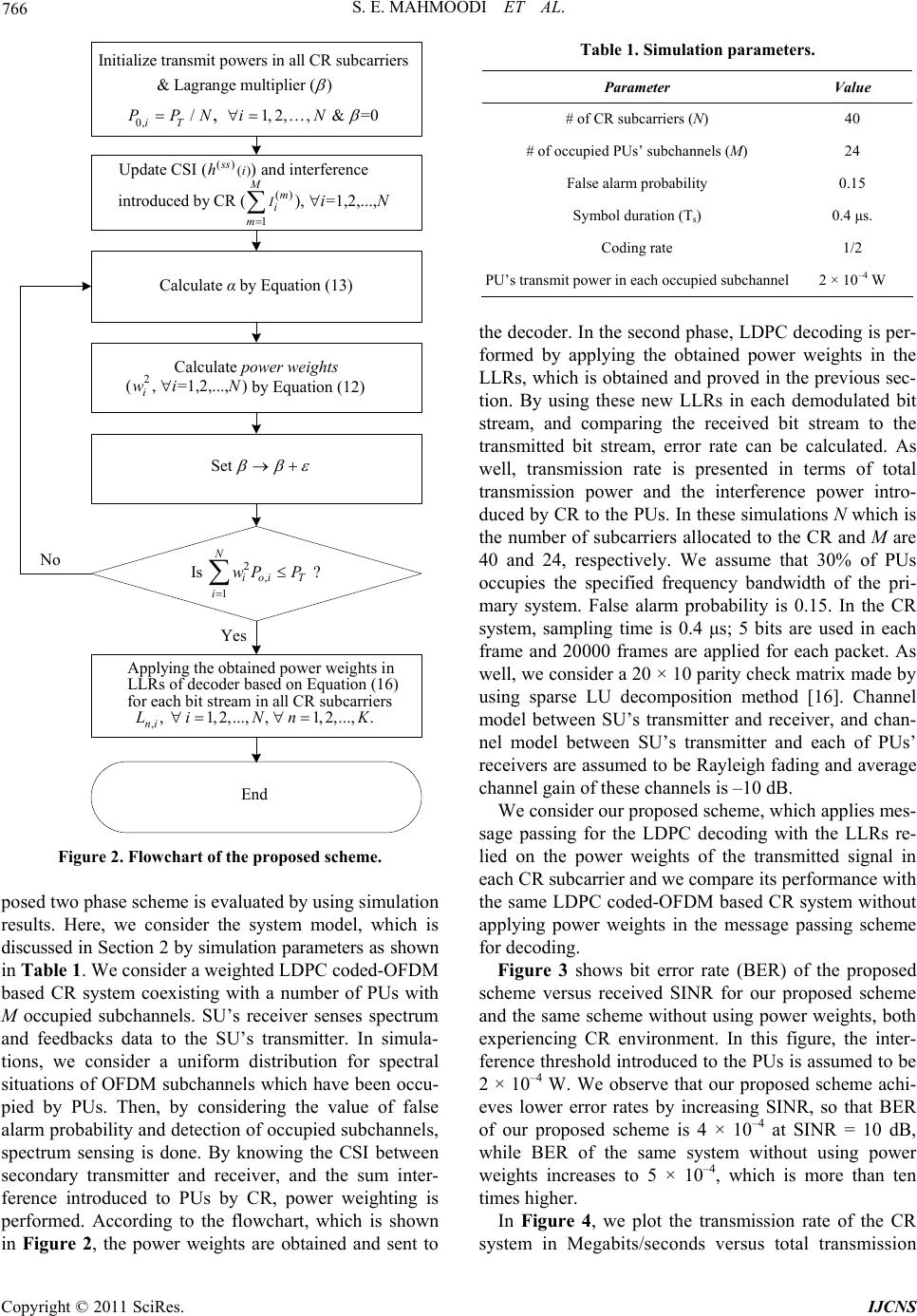 766 S. E. MAHMOODI ET AL. Calculate α by Equation (13) Calculate power weights by Equation (12) Yes No 0, /1,2,, & =0 , iT PPNi N , Applying the obtained power weights in LLRs of decoder based on Equation (16) for each bit stream in all CR subcarriers , 1,2,...,,1,2,...,. ni LiNn K End Initialize transmit powers in all CR subcarriers & Lagrange multiplier () 2 (, =1,2,...,) i wi N 2 , 1 Is ? N ioi T i wP P Set () () 1 () Update CSI () and interference introduced by CR (), =1,2,..., ss Mm i m i I h iN Figure 2. Flowchart of the proposed scheme. posed two phase scheme is evaluated by using simulation results. Here, we consider the system model, which is discussed in Section 2 by simulation parameters as shown in Table 1. We consider a weighted LDPC coded-OFDM based CR system coexisting with a number of PUs with M occupied subchannels. SU’s receiver senses spectrum and feedbacks data to the SU’s transmitter. In simula- tions, we consider a uniform distribution for spectral situations of OFDM subchannels which have been occu- pied by PUs. Then, by considering the value of false alarm probability and detection of occupied subchannels, spectrum sensing is done. By knowing the CSI between secondary transmitter and receiver, and the sum inter- ference introduced to PUs by CR, power weighting is performed. According to the flowchart, which is shown in Figure 2, the power weights are obtained and sent to Table 1. Simulation parameters. Parameter Value # of CR subcarriers (N) 40 # of occupied PUs’ subchannels (M) 24 False alarm probability 0.15 Symbol duration (Ts) 0.4 μs. Coding rate 1/2 PU’s transmit power in each occupied subchannel 2 × 10–4 W the decoder. In the second phase, LDPC decoding is per- formed by applying the obtained power weights in the LLRs, which is obtained and proved in the previous sec- tion. By using these new LLRs in each demodulated bit stream, and comparing the received bit stream to the transmitted bit stream, error rate can be calculated. As well, transmission rate is presented in terms of total transmission power and the interference power intro- duced by CR to the PUs. In these simulations N which is the number of subcarriers allocated to the CR and M are 40 and 24, respectively. We assume that 30% of PUs occupies the specified frequency bandwidth of the pri- mary system. False alarm probability is 0.15. In the CR system, sampling time is 0.4 μs; 5 bits are used in each frame and 20000 frames are applied for each packet. As well, we consider a 20 × 10 parity check matrix made by using sparse LU decomposition method [16]. Channel model between SU’s transmitter and receiver, and chan- nel model between SU’s transmitter and each of PUs’ receivers are assumed to be Rayleigh fading and average channel gain of these channels is –10 dB. We consider our proposed scheme, which applies mes- sage passing for the LDPC decoding with the LLRs re- lied on the power weights of the transmitted signal in each CR subcarrier and we compare its performance with the same LDPC coded-OFDM based CR system without applying power weights in the message passing scheme for decoding. Figure 3 shows bit error rate (BER) of the proposed scheme versus received SINR for our proposed scheme and the same scheme without using power weights, both experiencing CR environment. In this figure, the inter- ference threshold introduced to the PUs is assumed to be 2 × 10–4 W. We observe that our proposed scheme achi- eves lower error rates by increasing SINR, so that BER of our proposed scheme is 4 × 10–4 at SINR = 10 dB, while BER of the same system without using power weights increases to 5 × 10–4, which is more than ten times higher. In Figure 4, we plot the transmission rate of the CR system in Megabits/seconds versus total transmission Copyright © 2011 SciRes. IJCNS 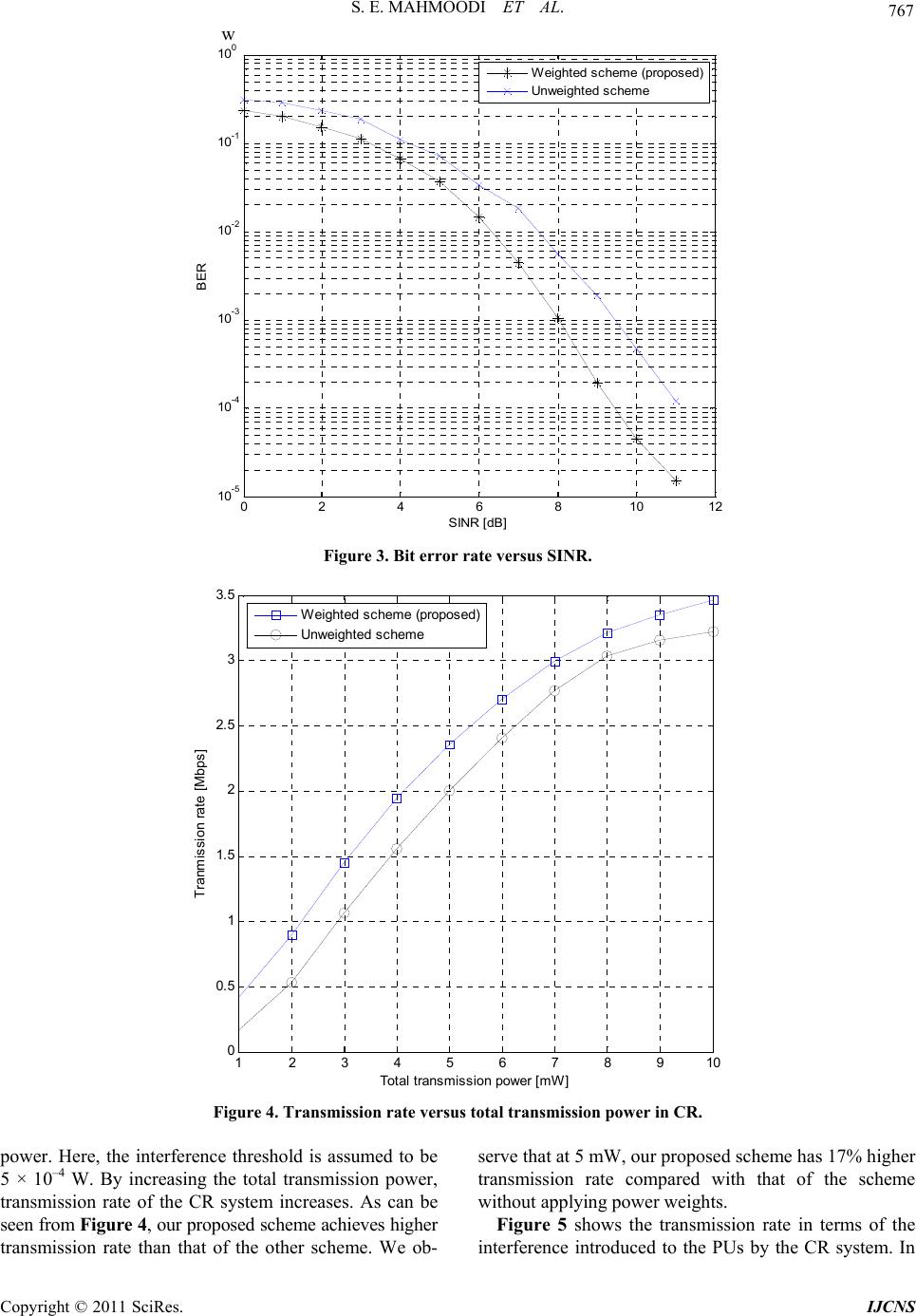 S. E. MAHMOODI ET AL. Copyright © 2011 SciRes. IJCNS 767 w 02 4 6 810 12 10-5 10-4 10-3 10-2 10-1 100 SINR [dB] BER Wei ghted sc hem e (propos ed) Unweight ed scheme Figure 3. Bit error rate versus SINR. 12 3 4 5 6 7 8 910 0 0. 5 1 1. 5 2 2. 5 3 3. 5 Total transmission power [mW] Tranmission rate [Mbps] Weight ed s cheme (propos ed) Unweighted scheme Figure 4. Transmission rate versus total transmission power in CR. power. Here, the interference threshold is assumed to be 5 × 10–4 W. By increasing the total transmission power, transmission rate of the CR system increases. As can be seen from Figure 4, our proposed scheme achieves higher transmission rate than that of the other scheme. We ob- serve that at 5 mW, our proposed scheme has 17% higher transmission rate compared with that of the scheme without applying power weights. Figure 5 shows the transmission rate in terms of the interference introduced to the PUs by the CR system. In 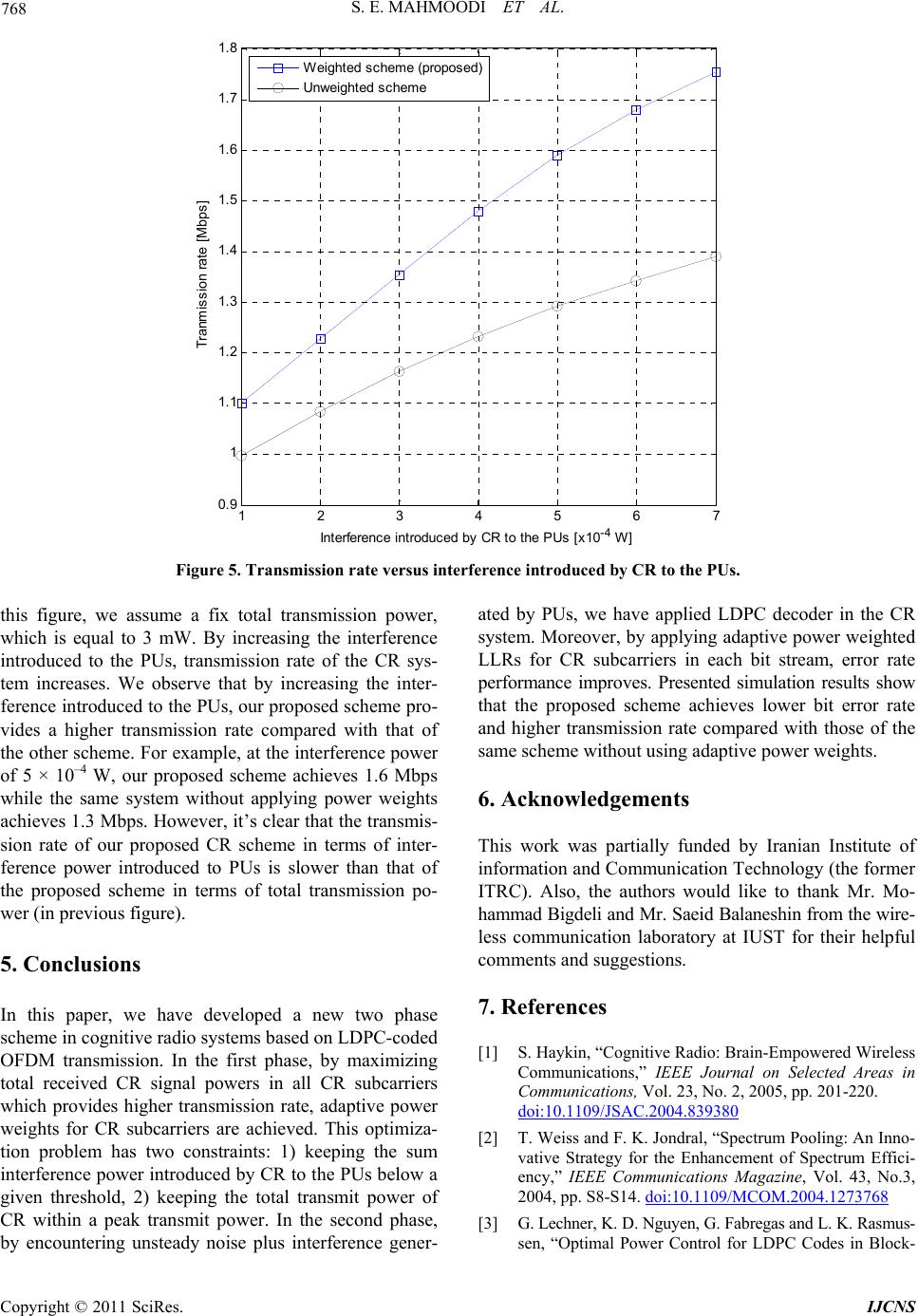 768 S. E. MAHMOODI ET AL. 1234567 0.9 1 1.1 1.2 1.3 1.4 1.5 1.6 1.7 1.8 Int erferenc e introduced by CR t o t he P Us [x10 -4 W] Tranmi ss ion rat e [Mbps ] Weight ed s cheme (proposed) Unweighted sc heme Figure 5. Transmission rate versus interference introduced by CR to the PUs. this figure, we assume a fix total transmission power, which is equal to 3 mW. By increasing the interference introduced to the PUs, transmission rate of the CR sys- tem increases. We observe that by increasing the inter- ference introduced to the PUs, our proposed scheme pro- vides a higher transmission rate compared with that of the other scheme. For example, at the interference power of 5 × 10–4 W, our proposed scheme achieves 1.6 Mbps while the same system without applying power weights achieves 1.3 Mbps. However, it’s clear that the transmis- sion rate of our proposed CR scheme in terms of inter- ference power introduced to PUs is slower than that of the proposed scheme in terms of total transmission po- wer (in previous figure). 5. Conclusions In this paper, we have developed a new two phase scheme in cognitive radio systems based on LDPC-coded OFDM transmission. In the first phase, by maximizing total received CR signal powers in all CR subcarriers which provides higher transmission rate, adaptive power weights for CR subcarriers are achieved. This optimiza- tion problem has two constraints: 1) keeping the sum interference power introduced by CR to the PUs below a given threshold, 2) keeping the total transmit power of CR within a peak transmit power. In the second phase, by encountering unsteady noise plus interference gener- ated by PUs, we have applied LDPC decoder in the CR system. Moreover, by applying adaptive power weighted LLRs for CR subcarriers in each bit stream, error rate performance improves. Presented simulation results show that the proposed scheme achieves lower bit error rate and higher transmission rate compared with those of the same scheme without using adaptive power weights. 6. Acknowledgements This work was partially funded by Iranian Institute of information and Communication Technology (the former ITRC). Also, the authors would like to thank Mr. Mo- hammad Bigdeli and Mr. Saeid Balaneshin from the wire- less communication laboratory at IUST for their helpful comments and suggestions. 7. References [1] S. Haykin, “Cognitive Radio: Brain-Empowered Wireless Communications,” IEEE Journal on Selected Areas in Communications, Vol. 23, No. 2, 2005, pp. 201-220. doi:10.1109/JSAC.2004.839380 [2] T. Weiss and F. K. Jondral, “Spectrum Pooling: An Inno- vative Strategy for the Enhancement of Spectrum Effici- ency,” IEEE Communications Magazine, Vol. 43, No.3, 2004, pp. S8-S14. doi:10.1109/MCOM.2004.1273768 [3] G. Lechner, K. D. Nguyen, G. Fabregas and L. K. Rasmus- sen, “Optimal Power Control for LDPC Codes in Block- Copyright © 2011 SciRes. IJCNS 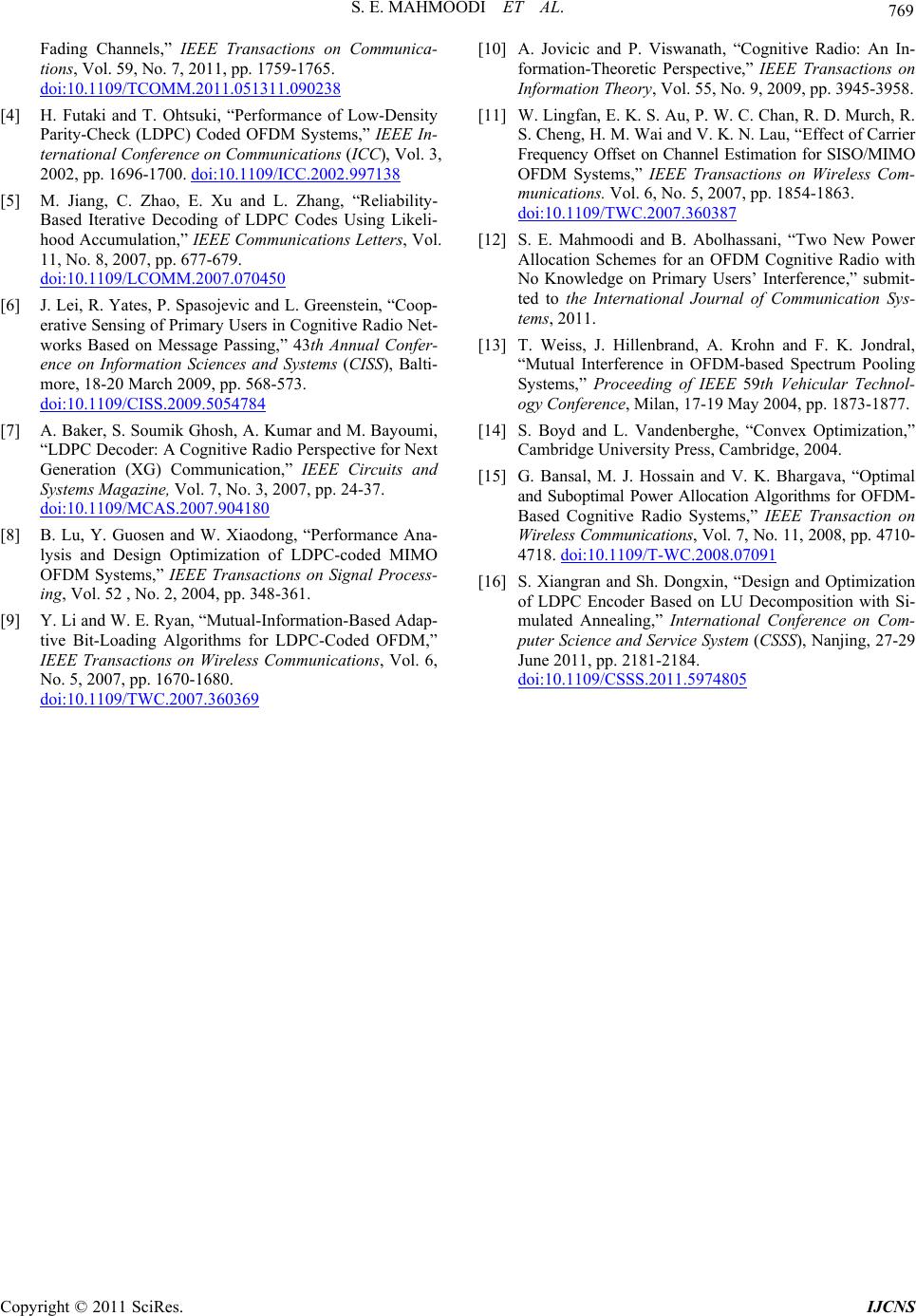 S. E. MAHMOODI ET AL. 769 Fading Channels,” IEEE Transactions on Communica- tions, Vol. 59, No. 7, 2011, pp. 1759-1765. doi:10.1109/TCOMM.2011.051311.090238 [4] H. Futaki and T. Ohtsuki, “Performance of Low-Density Parity-Check (LDPC) Coded OFDM Systems,” IEEE In- ternational Conference on Communications (ICC), Vol. 3, 2002, pp. 1696-1700. doi:10.1109/ICC.2002.997138 [5] M. Jiang, C. Zhao, E. Xu and L. Zhang, “Reliability- Based Iterative Decoding of LDPC Codes Using Likeli- hood Accumulation,” IEEE Communications Letters, Vol. 11, No. 8, 2007, pp. 677-679. doi:10.1109/LCOMM.2007.070450 [6] J. Lei, R. Yates, P. Spasojevic and L. Greenstein, “Coop- erative Sensing of Primary Users in Cognitive Radio Net- works Based on Message Passing,” 43th Annual Confer- ence on Information Sciences and Systems (CISS), Balti- more, 18-20 March 2009, pp. 568-573. doi:10.1109/CISS.2009.5054784 [7] A. Baker, S. Soumik Ghosh, A. Kumar and M. Bayoumi, “LDPC Decoder: A Cognitive Radio Perspective for Next Generation (XG) Communication,” IEEE Circuits and Systems Magazine, Vol. 7, No. 3, 2007, pp. 24-37. doi:10.1109/MCAS.2007.904180 [8] B. Lu, Y. Guosen and W. Xiaodong, “Performance Ana- lysis and Design Optimization of LDPC-coded MIMO OFDM Systems,” IEEE Transactions on Signal Process- ing, Vol. 52 , No. 2, 2004, pp. 348-361. [9] Y. Li and W. E. Ryan, “Mutual-Information-Based Adap- tive Bit-Loading Algorithms for LDPC-Coded OFDM,” IEEE Transactions on Wireless Communications, Vol. 6, No. 5, 2007, pp. 1670-1680. doi:10.1109/TWC.2007.360369 [10] A. Jovicic and P. Viswanath, “Cognitive Radio: An In- formation-Theoretic Perspective,” IEEE Transactions on Information Theory, Vol. 55, No. 9, 2009, pp. 3945-3958. [11] W. Lingfan, E. K. S. Au, P. W. C. Chan, R. D. Murch, R. S. Cheng, H. M. Wai and V. K. N. Lau, “Effect of Carrier Frequency Offset on Channel Estimation for SISO/MIMO OFDM Systems,” IEEE Transactions on Wireless Com- munications. Vol. 6, No. 5, 2007, pp. 1854-1863. doi:10.1109/TWC.2007.360387 [12] S. E. Mahmoodi and B. Abolhassani, “Two New Power Allocation Schemes for an OFDM Cognitive Radio with No Knowledge on Primary Users’ Interference,” submit- ted to the International Journal of Communication Sys- tems, 2011. [13] T. Weiss, J. Hillenbrand, A. Krohn and F. K. Jondral, “Mutual Interference in OFDM-based Spectrum Pooling Systems,” Proceeding of IEEE 59th Vehicular Technol- ogy Conference, Milan, 17-19 May 2004, pp. 1873-1877. [14] S. Boyd and L. Vandenberghe, “Convex Optimization,” Cambridge University Press, Cambridge, 2004. [15] G. Bansal, M. J. Hossain and V. K. Bhargava, “Optimal and Suboptimal Power Allocation Algorithms for OFDM- Based Cognitive Radio Systems,” IEEE Transaction on Wireless Communications, Vol. 7, No. 11, 2008, pp. 4710- 4718. doi:10.1109/T-WC.2008.07091 [16] S. Xiangran and Sh. Dongxin, “Design and Optimization of LDPC Encoder Based on LU Decomposition with Si- mulated Annealing,” International Conference on Com- puter Science and Service System (CSSS), Nanjing, 27-29 June 2011, pp. 2181-2184. doi:10.1109/CSSS.2011.5974805 Copyright © 2011 SciRes. IJCNS
|